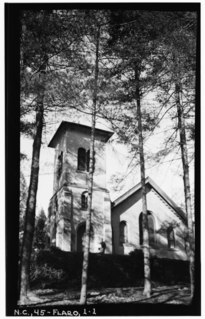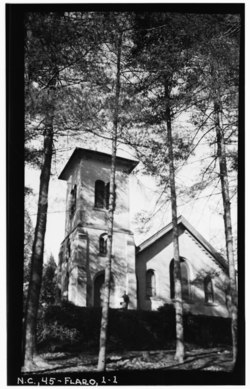
Asheville is a city and the county seat of Buncombe County, North Carolina, United States. It is the largest city in Western North Carolina, and the 12th-most populous city in the U.S. state of North Carolina. The city's population was 92,452 according to 2018 estimates. It is the principal city in the four-county Asheville metropolitan area, with a population of 424,858 in 2010.

Flat Rock is a village in Henderson County, North Carolina, United States. The population was 3,114 at the 2010 census. It is part of the Asheville Metropolitan Statistical Area.

The French Quarter is historict district and a section of downtown Charleston, South Carolina, United States, that is listed on the National Register of Historic Places.

The Episcopal Diocese of Western North Carolina is a diocese in the Episcopal Church. It consists of 28 counties in western North Carolina and its episcopal see is in Asheville, North Carolina, seated at Cathedral of All Souls. The first recorded worship from the Book of Common Prayer west of the Catawba River was in 1786. Valle Crucis, where one of the two conference centers is located, began as a missionary outpost in 1842. In 1894, a resolution was adopted in the Convention of the Diocese of North Carolina that the Western part of the State be set off and offered to the General Church as a Missionary District. The following year, in November 1895, the first Convention of the District of Asheville was held at Trinity Church in Asheville. In 1922, after all the requirements had been fulfilled, a petition from the Jurisdiction of Asheville to become the Diocese of Western North Carolina was presented at the General Convention of The Episcopal Church. It was accepted on September 12, 1922.

Chapel of the Cross is a parish of the Episcopal Church of the United States in Chapel Hill in the Diocese of North Carolina. It is the spiritual home to more than 1,600 communicants, including numerous students studying at the University of North Carolina at Chapel Hill.

Christ Episcopal Church, also known as Christ Church on Capitol Square, is an Episcopal church at 120 East Edenton Street in Raleigh, North Carolina. Built in 1848-53 to a design by Richard Upjohn, it is one of the first Gothic Revival churches in the American South. The church was built for a parish established in 1821; its minister is the Rev. James P. Adams. It was declared a National Historic Landmark in 1987.

St. James Church, Santee, also known as St. James Episcopal Church, Santee, is a historic church located in a remote portion of Francis Marion National Forest in Charleston County, South Carolina. Built in 1768, it is a remarkably sophisticated expression of fashionable Georgian architecture in a remote area, and was designated a National Historic Landmark in 1970 for its architectural significance. It is located on the west side of the Old Georgetown Road, several miles north of South Carolina Highway 46 and McClellanville.

Edward Brickell White, also known as E. B. White, was an American architect. He was known for his Gothic Revival architecture and his use of Roman and Greek designs.

St. Michael's Episcopal Church is a historic church and the oldest surviving religious structure in Charleston, South Carolina. It is located at Broad and Meeting streets on one of the Four Corners of Law, and represents ecclesiastical law. It was built in the 1750s by order of the South Carolina Assembly. It is listed on the National Register of Historic Places and is a National Historic Landmark.

St. Mary's Episcopal Church is an Anglo-Catholic Episcopal parish in Asheville, North Carolina in the Episcopal Diocese of Western North Carolina

This is a list of the National Register of Historic Places listings in Charleston County, South Carolina.

The Cathedral of All Souls, also referred to as All Souls Cathedral, is an Episcopal cathedral located in Asheville, North Carolina, United States of America. All Souls was built by railroad baron George Washington Vanderbilt II in 1896 to serve as the local parish church for Biltmore Village, which had been developed near his Biltmore Estate. The Right Reverend José Antonio McLoughlin is the current bishop seated at the cathedral.

Flat Rock Historic District is a national historic district located at Flat Rock, Henderson County, North Carolina. The district encompasses 55 contributing buildings and 1 contributing site associated with estates centering on the ambitious summer houses of the prominent Charlestonians. The homes includes notable examples of Stick Style / Eastlake Movement, Second Empire, and Gothic Revival residential architecture. Located in the district is the separately listed Carl Sandburg Home National Historic Site, also known as Connemara. Other notable estates include Mountain Lodge, Argyle, Beaumont, Tall Trees (Greenlawn), Many Pines, Chanteloupe, Teneriffe, Rutledge Cottage, Dunroy, Treholm-Rhett House home of George Trenholm, Kenmure (Glenroy), Vincennes home of William Elliott, Sallie Parker House, Enchantment, Bonclarken (Heidleberg), Saluda Cottages, Tranquility, and the Rhue House. Also located in the district is St. John-in-the-Wilderness church and rectory, the Old Post Office, Woodfield Inn, The Lowndes Place.

Valle Crucis Episcopal Mission, also known as Valle Crucis Conference Center, is a historic Episcopal mission church complex and national historic district located near Valle Crucis, Watauga County, North Carolina. The Gothic Revival style, gable-front stone Church of the Holy Cross was built about 1924. Other contributing resources are the church cemetery with the earliest burial dated to 1808, Auchmutv Hall dormitory (1910-1911), The Annex, "The Farm House" (1915), Former Dairy Barn, Former Apple Barn, The Mission House (1896), the Power Dam (1903-1930), the Valley / Field, and the Apple Orchard. The Valle Crucis Episcopal Mission was established by the Episcopal Church in 1844-1845.

Edward Culliatt Jones was an American architect from Charleston, South Carolina. A number of his works are listed on the U.S. National Register of Historic Places, and one is further designated a U.S. National Historic Landmark. His works include the following :

St. Matthias Episcopal Church is a parish of the Episcopal Church located at Asheville, Buncombe County, North Carolina, in the Diocese of Western North Carolina. Founded in 1867, St. Matthias believes itself to be the oldest African-American congregation in the city.

Downtown Asheville Historic District is a national historic district located at Asheville, Buncombe County, North Carolina. The district encompasses about 279 contributing buildings and 1 contributing objects in the central business district of Asheville. It includes commercial, institutional, and residential buildings in a variety of popular architectural styles including Colonial Revival, Queen Anne, and Art Deco.

The Emanuel African Methodist Episcopal Church, often referred to as Mother Emanuel, is a church in Charleston, South Carolina. Founded in 1817, Emanuel AME is the oldest African Methodist Episcopal church in the Southern United States. This first independent black denomination in the United States was founded in 1816 in Philadelphia, Pennsylvania.





















